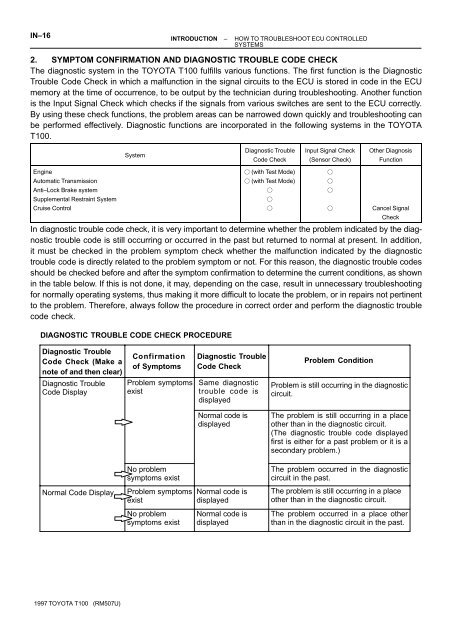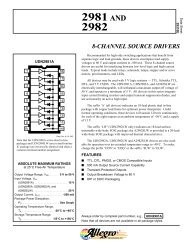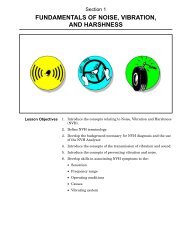how to use this manual general information - 757.org
how to use this manual general information - 757.org
how to use this manual general information - 757.org
You also want an ePaper? Increase the reach of your titles
YUMPU automatically turns print PDFs into web optimized ePapers that Google loves.
IN–16 INTRODUCTION – HOW TO TROUBLESHOOT ECU CONTROLLED<br />
SYSTEMS<br />
2. SYMPTOM CONFIRMATION AND DIAGNOSTIC TROUBLE CODE CHECK<br />
The diagnostic system in the TOYOTA T100 fulfills various functions. The first function is the Diagnostic<br />
Trouble Code Check in which a malfunction in the signal circuits <strong>to</strong> the ECU is s<strong>to</strong>red in code in the ECU<br />
memory at the time of occurrence, <strong>to</strong> be output by the technician during troubleshooting. Another function<br />
is the Input Signal Check which checks if the signals from various switches are sent <strong>to</strong> the ECU correctly.<br />
By using these check functions, the problem areas can be narrowed down quickly and troubleshooting can<br />
be performed effectively. Diagnostic functions are incorporated in the following systems in the TOYOTA<br />
T100.<br />
Engine<br />
Au<strong>to</strong>matic Transmission<br />
Anti–Lock Brake system<br />
Supplemental Restraint System<br />
Cruise Control<br />
DIAGNOSTIC TROUBLE CODE CHECK PROCEDURE<br />
Diagnostic Trouble<br />
Code Check (Make a<br />
note of and then clear)<br />
Diagnostic Trouble<br />
Code Display<br />
Normal Code Display<br />
1997 TOYOTA T100 (RM507U)<br />
System<br />
Confirmation<br />
of Symp<strong>to</strong>ms<br />
Problem symp<strong>to</strong>ms<br />
exist<br />
No problem<br />
symp<strong>to</strong>ms exist<br />
Problem symp<strong>to</strong>ms<br />
exist<br />
No problem<br />
symp<strong>to</strong>ms exist<br />
Diagnostic Trouble<br />
Code Check<br />
Same diagnostic<br />
trouble code is<br />
displayed<br />
Normal code is<br />
displayed<br />
Normal code is<br />
displayed<br />
Normal code is<br />
displayed<br />
Diagnostic Trouble<br />
Code Check<br />
� (with Test Mode)<br />
� (with Test Mode)<br />
�<br />
�<br />
�<br />
Input Signal Check<br />
(Sensor Check)<br />
�<br />
�<br />
�<br />
Problem Condition<br />
Other Diagnosis<br />
Function<br />
� Cancel Signal<br />
Check<br />
In diagnostic trouble code check, it is very important <strong>to</strong> determine whether the problem indicated by the diagnostic<br />
trouble code is still occurring or occurred in the past but returned <strong>to</strong> normal at present. In addition,<br />
it must be checked in the problem symp<strong>to</strong>m check whether the malfunction indicated by the diagnostic<br />
trouble code is directly related <strong>to</strong> the problem symp<strong>to</strong>m or not. For <strong>this</strong> reason, the diagnostic trouble codes<br />
should be checked before and after the symp<strong>to</strong>m confirmation <strong>to</strong> determine the current conditions, as s<strong>how</strong>n<br />
in the table below. If <strong>this</strong> is not done, it may, depending on the case, result in unnecessary troubleshooting<br />
for normally operating systems, thus making it more difficult <strong>to</strong> locate the problem, or in repairs not pertinent<br />
<strong>to</strong> the problem. Therefore, always follow the procedure in correct order and perform the diagnostic trouble<br />
code check.<br />
Problem is still occurring in the diagnostic<br />
circuit.<br />
The problem is still occurring in a place<br />
other than in the diagnostic circuit.<br />
(The diagnostic trouble code displayed<br />
first is either for a past problem or it is a<br />
secondary problem.)<br />
The problem occurred in the diagnostic<br />
circuit in the past.<br />
The problem is still occurring in a place<br />
other than in the diagnostic circuit.<br />
The problem occurred in a place other<br />
than in the diagnostic circuit in the past.





